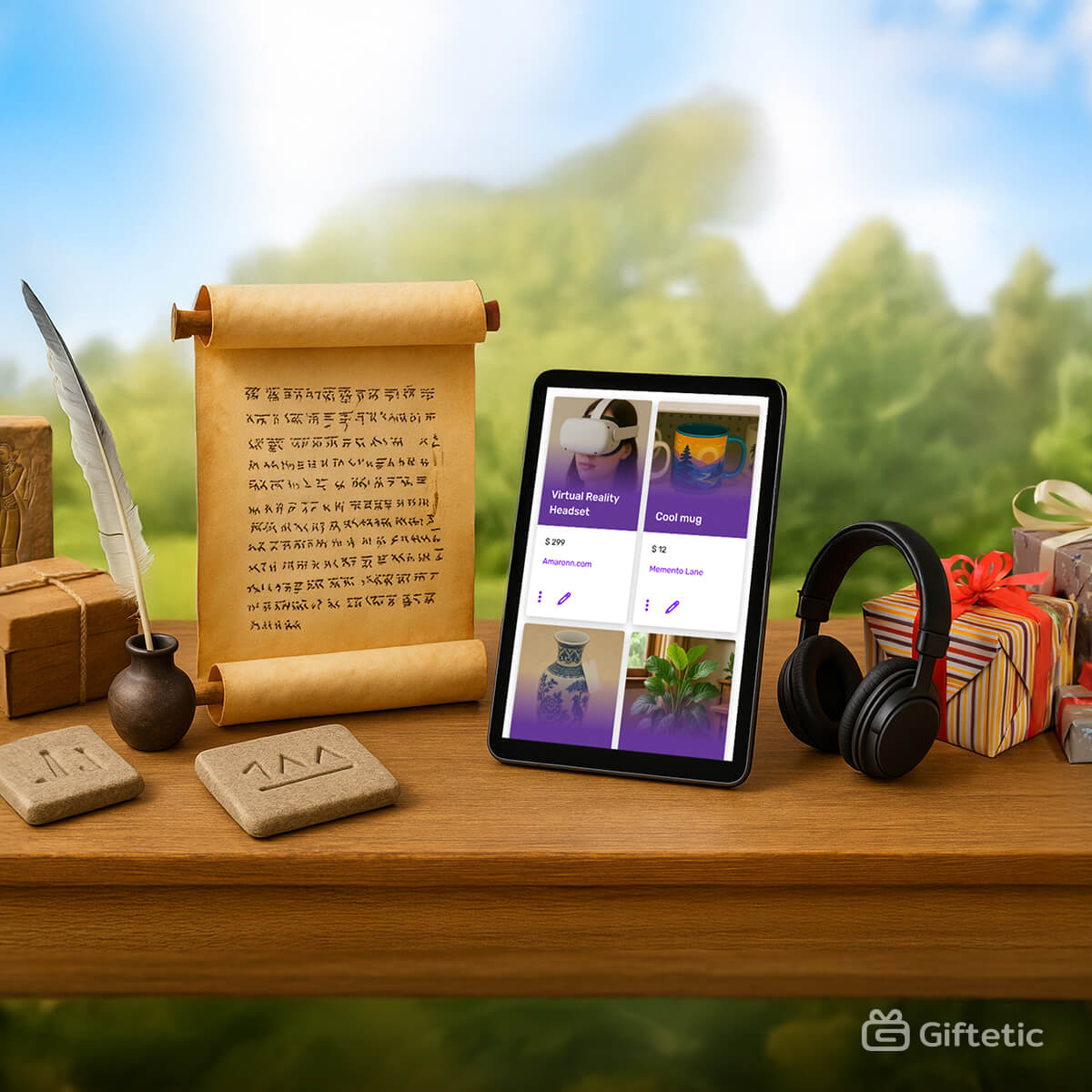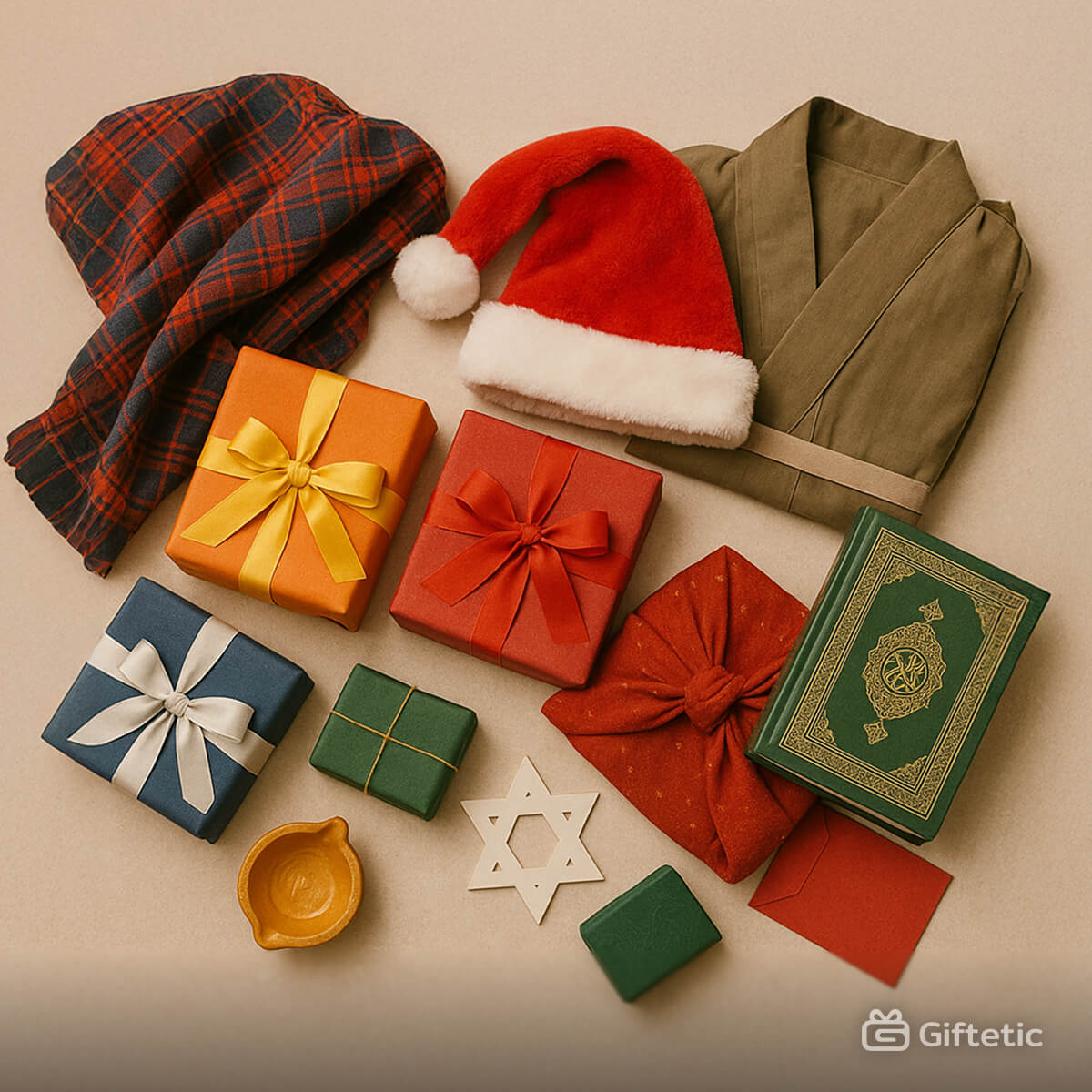Why Do We Give Gifts? The Origins, Evolution, and Meaning Behind Gift-Giving
From the first carved stone tools shared among early humans to today's carefully curated digital wishlists, gift-giving has woven itself into the very fabric of human experience. Whether it's a child's handmade card, a thoughtfully chosen wedding registry item, or a surprise vacation planned months in advance, the act of giving transcends cultures, religions, and centuries. But why do we feel compelled to give? What drives this universal human behavior that transforms simple objects into symbols of love, respect, and connection? The story of gift-giving is ultimately the story of us — a tale of survival, social bonds, and the endless human desire to show we care.
Quick Summary (TL;DR)
- Ancient Origins: Gift-giving began with early humans and parallels exist in our closest primate relatives
- Social Function: Gifts serve as "social glue," building alliances, showing status, and strengthening community bonds
- Cultural Evolution: From religious offerings to modern consumer culture, gifting practices reflect societal values
- Psychological Drivers: We give to experience the "warm glow" effect, express gratitude, and signal our values
- Modern Transformation: Digital age has revolutionized how we discover, organize, and share gift ideas
- Cultural Sensitivity: Understanding diverse gifting traditions prevents misunderstandings and shows respect
- Future Focus: Contemporary trends emphasize experiences, personalization, and sustainable giving
The Origins of Gifting
The Dawn of Exchange: Paleolithic Beginnings
The story of gift-giving begins in the mists of prehistory, with archaeological evidence pointing to organized exchange systems among early Homo sapiens as far back as 100,000 years ago. Excavations at sites like Blombos Cave in South Africa have revealed intricately carved ochre pieces and perforated shells that traveled hundreds of miles from their origins — clear evidence that our ancestors were already engaging in long-distance gift exchange networks.
The famous Grotte du Renne site in France, dating to approximately 45,000 years ago, provides even more compelling evidence. Here, archaeologists discovered ornamental objects made from materials sourced from distant locations, suggesting that Neanderthals and early modern humans participated in sophisticated gift-exchange systems that served both practical and symbolic purposes.
Evolutionary Foundations: What Our Primate Cousins Teach Us
To understand why humans developed such elaborate gifting behaviors, we need only look to our closest evolutionary relatives. Chimpanzees demonstrate remarkable gift-giving behaviors that mirror our own: they share meat after successful hunts, offer grooming services to build alliances, present stones and sticks as reconciliation tokens, and even engage in "gift" exchanges during courtship rituals.
Bonobos take this further, using gift-giving to establish and maintain complex social hierarchies. Female bonobos often present food to males not out of submission, but as a way to control access to resources and influence group dynamics. This behavior suggests that strategic giving — using gifts to achieve social goals — is deeply embedded in our evolutionary heritage.
"Gift exchange is one of the most ancient and universal human behaviors. It's so fundamental that we see traces of it in our closest primate relatives."
Archaeological Evidence: The First "Luxury" Gifts
Some of humanity's earliest gifts weren't practical tools or food — they were beautiful, seemingly "useless" objects that served purely symbolic purposes. The 82,000-year-old Nassarius shell beads found in North Africa represent some of the earliest evidence of purely decorative gift items. These tiny shells, carefully perforated and often colored with ochre, required significant time investment to create and had no practical function beyond personal adornment.
The discovery of the "Lonely Skeleton" in Sunghir, Russia, dating to 34,000 years ago, provides perhaps the most spectacular example of prehistoric gift-giving. This child's burial contained over 5,000 ivory beads, mammoth tusk spears, and other elaborate grave goods that would have taken thousands of hours to create. The investment of time and resources suggests that even in prehistoric times, gifts served to honor relationships and express profound emotions.
The Survival Strategy Behind Ancient Generosity
These early exchanges weren't random acts of kindness — they were calculated investments in survival networks that anthropologists call "risk reduction strategies." In environments where food sources were unpredictable and dangers constant, gift-giving created reciprocal obligations that functioned as primitive insurance systems.
When a successful hunter shared meat with neighboring families, they weren't just being generous — they were investing in future assistance during lean times. Archaeological evidence from sites like Dolni Vestonice in the Czech Republic shows that 26,000 years ago, communities were sharing exotic materials like amber and shells across vast distances, creating trade networks that would have provided both material resources and crucial information about distant territories.
These ancient gift-giving networks laid the foundation for everything that followed. When an early human offered a handful of berries to a stranger, they were participating in humanity's first social technology — a system for building trust, sharing risk, and creating the cooperative relationships that would ultimately allow our species to dominate the planet.
Rituals & Religion: Meaning Across Civilizations
As civilizations developed, gift-giving evolved from survival strategy to sacred ritual. Ancient Egyptians filled tombs with treasures for the afterlife journey, while Mesopotamians offered precious items to their gods in elaborate temple ceremonies. These weren't just religious observances — they were sophisticated systems of social organization that reinforced hierarchies and community bonds.
The ancient Greeks institutionalized generosity through xenia — the sacred relationship between guest and host that required lavish hospitality and gift exchange. Romans elevated this further with munera, public gifts that demonstrated civic virtue and political power. Meanwhile, in ancient China, Confucian li prescribed elaborate gift-giving protocols that reinforced social harmony and respect for elders.
Perhaps no gift-giving tradition has had more lasting impact than the story of the Magi bearing gold, frankincense, and myrrh to the Christ child. This narrative, combined with the legend of Saint Nicholas distributing gifts to children, laid the foundation for modern Christmas traditions. The integration of these stories with winter solstice celebrations created powerful cultural associations between giving and seasonal renewal that persist today.
Across cultures, specific gift-giving traditions emerged that reflected local values and beliefs:
- Hongbao (Red Envelopes): Chinese tradition of giving money in red packets during celebrations, symbolizing good luck and prosperity
- Potlatch: Pacific Northwest Indigenous ceremonies where chiefs gave away enormous quantities of goods to demonstrate wealth and gain prestige
- Kula Ring: Melanesian inter-island trading system where ceremonial shell ornaments circulated for generations, building lasting relationships
- Koha: Māori tradition of reciprocal giving that maintains balance and respect in relationships
These ancient traditions continue to influence modern celebrations worldwide. From Diwali's exchange of sweets and gold to Eid's practice of giving gifts to children, cultural gift-giving practices have evolved while maintaining their core meaning. For a comprehensive look at how these traditions manifest in today's global celebrations, explore our guide to gift-giving holidays and traditions around the world.
Gifts and Power Dynamics
Not all gifts are created equal, and throughout history, giving has often been as much about power as generosity. The potlatch ceremonies of Pacific Northwest Indigenous peoples perfectly illustrate this dynamic. Chiefs would compete to give away the most valuable items — blankets, copper shields, even canoes — not out of altruism, but to demonstrate their wealth and secure their social position.
Modern research has identified two distinct types of gifts: instrumental and expressive. Instrumental gifts are strategic, designed to influence behavior or signal status. Think of corporate gifts, political donations, or expensive engagement rings. Expressive gifts, on the other hand, focus on emotional connection and relationship building — a handwritten letter, a photo album, or a surprise experience planned around someone's interests.
"A gift is never just a gift. It's a statement about relationships, power, and how we see ourselves in the social world."
Gender dynamics have also historically influenced gift-giving patterns. Traditional expectations often placed women in the role of gift managers — remembering birthdays, selecting presents, and maintaining family relationships through thoughtful giving. Today's smart reminder systems help distribute this emotional labor more equitably, allowing anyone to become a thoughtful gift-giver regardless of traditional gender roles.
Transformation Through Time
Medieval Europe saw gift-giving become increasingly formalized through dowries, symbolic tokens, and elaborate court ceremonies. Knights exchanged tokens of favor, merchants sealed deals with ceremonial cups, and religious pilgrims brought back blessed items as proof of their journeys. These practices established gift-giving as both personal expression and public performance.
The Victorian era marked a pivotal transformation in how we approach gifts. The rise of sentimentalism made emotional expression through objects socially acceptable and even expected. This period saw the emergence of gift baskets, greeting cards, and the concept of "appropriate" gifts for different relationships and occasions. The Hallmark Company, founded in 1910, capitalized on these changing attitudes by creating products specifically designed to help people express feelings they couldn't articulate themselves.
The 20th century brought mass production and democratized gift-giving. Suddenly, beautifully crafted items that once required months of skilled labor could be purchased by anyone with modest means. This shift from handcrafted to mass-produced gifts changed the meaning of giving — the value shifted from the time and skill invested in creation to the thought and care invested in selection.
"The industrialization of gift-giving didn't diminish its meaning — it transformed it. Now the gift was not in the making, but in the choosing."
Modern Gifting
Today's gift-giving landscape would be unrecognizable to our ancestors. We live in an era of unprecedented choice, where a single online marketplace offers millions of potential gifts that can be delivered within hours. This abundance has created both opportunities and challenges — while we have access to perfect gifts for any occasion, the sheer volume of options can feel overwhelming.
The rise of seasonal gifting pressure has transformed holidays into major economic events. Americans alone spend over $1 trillion annually on gifts, with retailers depending on holiday seasons for a significant portion of their yearly revenue. This commercialization has sparked ongoing debates about authenticity versus consumption, leading many to seek more meaningful approaches to giving.
Gift wrapping itself has become an art form and industry. What started as simple brown paper evolved into elaborate presentations with specialized papers, ribbons, and accessories. The visual presentation of a gift now carries almost as much meaning as the gift itself, creating anticipation and demonstrating the giver's investment in the recipient's experience.
Millennials and Gen Z have begun reshaping gift-giving traditions, prioritizing experiences over objects and personalization over price. They're more likely to give concert tickets than expensive jewelry, cooking classes than kitchen appliances, or charitable donations than luxury items. This generation also embraces digital gifts — subscription services, online courses, and even virtual experiences that would have been impossible just decades ago.
Modern wishlist systems have revolutionized how we discover and share gift preferences, making it easier than ever to give meaningful presents while reducing waste and disappointment. These platforms, like Giftetic, reflect our evolving understanding that the best gifts aren't surprises — they're thoughtful responses to clearly expressed desires and needs.
As digital gifting tools have evolved, so has the terminology surrounding them. Many people use terms like 'wishlist,' 'gift registry,' and 'personal wish list' interchangeably, but understanding the distinctions can help you choose the right solution for your needs. Whether you're creating a birthday wishlist, setting up a wedding gift registry, or organizing gift ideas for family members, knowing which tool serves your specific gifting goals ensures the best experience for both givers and recipients.
Recommendation: For a comprehensive breakdown of these commonly confused terms and their practical applications, explore our guide to personal wish lists vs wishlists vs gift registries.

What Is a Wishlist? Everything You Need to Know About How It Works and Why It Matters
Wishlist BasicsPsychology & Motivations Today
Neuroscience has revealed fascinating insights into why giving feels so good. When we give gifts, our brains release dopamine, serotonin, and oxytocin — the same "feel-good" chemicals associated with falling in love or experiencing profound joy. This "warm glow" effect explains why many people report that giving brings them more happiness than receiving.
But our motivations for giving are complex and often unconscious. We give to express gratitude, demonstrate love, show respect, celebrate achievements, offer comfort, and mark important transitions. Each gift carries multiple layers of meaning, serving as a form of non-verbal communication that can express sentiments we struggle to put into words.
Social psychologists have identified several key drivers behind modern gift-giving:
- Reciprocity: The fundamental human need to return kindness and maintain balanced relationships
- Status Signaling: Using gifts to communicate our taste, values, and social position
- Moral Signaling: Demonstrating our character and ethical commitments through our giving choices
- Self-Expression: Using gifts to show who we are and how we see our relationships
- Emotional Regulation: Managing guilt, obligation, or desire for social approval
"The act of giving activates the same neural pathways as receiving unexpected rewards. In essence, our brains are wired to find joy in generosity."
Understanding these motivations can help us become more intentional gift-givers, focusing on presents that truly serve our relationships rather than simply fulfilling social obligations. Tools that help us track our giving history can prevent duplicate gifts while ensuring our generosity feels fresh and thoughtful over time.
The science behind relationship-building through gifts reveals that thoughtful giving can strengthen bonds in measurable ways. From deepening romantic partnerships to building trust in professional relationships, strategic generosity serves as a powerful tool for human connection. For practical strategies on leveraging this ancient practice in modern relationships, discover how to build stronger relationships through thoughtful gifting.
Types of Gifts & Rituals
Contemporary gift-giving encompasses an enormous range of forms and functions, each carrying distinct meanings and expectations. Understanding these categories helps us navigate the complex social landscape of modern generosity.
Tangible versus intangible gifts represent perhaps the most fundamental distinction. Traditional tangible gifts — books, jewelry, electronics, home goods — remain popular because they provide lasting reminders of the giver's thoughtfulness. However, intangible gifts are gaining prominence, including experiences like travel, classes, and adventures, as well as digital offerings like streaming subscriptions, online courses, and virtual reality experiences.
Formal versus informal gifting operates according to different rules and expectations. Formal gifts accompany ceremonial occasions — weddings, graduations, religious ceremonies — and often follow established protocols regarding appropriateness and value. Informal gifts flow naturally through daily relationships, from bringing coffee to a colleague to surprising a partner with their favorite dessert.
Culture-specific gifting genres continue to thrive in our globalized world:
- Ceremonial offerings: Wedding registries, baby shower gifts, housewarming presents that mark life transitions
- Seasonal celebrations: Holiday gifts, birthday presents, anniversary commemorations
- Sympathy and support: Funeral flowers, get-well baskets, congratulatory gifts
- Business and professional: Client gifts, employee recognition, networking tokens
The emergence of curated gift collections reflects our desire to find perfect matches between givers, recipients, and occasions. These systems help us discover gifts that align with specific relationships, interests, and cultural contexts, making thoughtful giving more accessible and less stressful.
Gifting in the Digital Age
The digital revolution has fundamentally transformed every aspect of gift-giving, from discovery to delivery to display. E-commerce platforms offer unprecedented selection and convenience, with same-day delivery making last-minute gifting possible in ways our grandparents could never imagine. Curated subscription services have created entirely new categories of gifts, allowing us to give ongoing experiences rather than single items.
Virtual gifts represent a fascinating evolution in gifting culture. Digital tokens, NFTs, online game items, and virtual experiences may lack physical form, but they can carry profound meaning for recipients who inhabit digital spaces. A rare skin in a favorite video game or exclusive access to online content can be more valuable to some recipients than traditional physical presents.
Social media has added a performative dimension to gift-giving that previous generations never experienced. Instagram posts showcasing thoughtful gifts, TikTok unboxing videos, and Facebook birthday wish compilations have made giving and receiving semi-public acts that contribute to our online personas and social connections.
"Digital platforms haven't replaced the human desire to give — they've amplified it. Now we can share our generosity with networks that span the globe."
Modern technology has also solved age-old gifting challenges. Privacy controls on wishlists allow recipients to share preferences without spoiling surprises, while smart reminder systems ensure important occasions never slip through the cracks. These innovations preserve the emotional core of gift-giving while eliminating much of the guesswork and stress that once accompanied thoughtful generosity.
Best Practices & Cultural Sensitivity
In our interconnected world, understanding diverse gifting traditions has become essential for maintaining respectful relationships across cultural boundaries. What constitutes an appropriate gift varies dramatically between cultures, and innocent mistakes can inadvertently cause offense or misunderstanding.
Some universal principles can guide culturally sensitive gift-giving:
- Research first: Learn about significant cultural or religious considerations before selecting gifts
- Ask when uncertain: Close friends and colleagues are usually happy to provide guidance about appropriate gifting practices
- Focus on thoughtfulness over expense: Sincere consideration of the recipient's preferences matters more than monetary value
- Respect religious and dietary restrictions: Avoid gifts that conflict with someone's beliefs or lifestyle choices
- Consider presentation: Some cultures place great importance on how gifts are wrapped, presented, or acknowledged
The growing movement toward sustainable and intentional gifting reflects broader cultural shifts toward environmental consciousness and mindful consumption. Many people now prefer gifts that align with their values — locally made items, experiences rather than objects, charitable donations, or products from socially responsible companies.
"The most meaningful gifts are those that show we truly see and understand the recipient as an individual, not just as someone who fits into a particular category."
Personalization has become the gold standard of thoughtful giving. Rather than selecting generic gifts, the most appreciated presents demonstrate specific knowledge of the recipient's interests, needs, and aspirations. This might mean curating a personalized wishlist based on someone's hobbies, or choosing an experience that reflects their bucket list dreams.

Popular Holidays When People Give Gifts — Ideas, Tips, and Traditions
Gifting Around the WorldConclusion: The Everlasting Value of Giving
As we've traced the journey from prehistoric tool-sharing to digital wish lists, one truth emerges clearly: gift-giving serves as a mirror of our humanity. It reflects our deepest values, our understanding of relationships, and our hope for connection in an often disconnected world. The specific forms may evolve — from carved bones to curated experiences — but the underlying impulse remains constant.
What makes gift-giving endure across millennia is its unique ability to bridge the gap between internal feelings and external expression. When words fail us, gifts speak. When distance separates us, presents connect us. When relationships need strengthening, thoughtful giving provides the tools.
In our contemporary world, platforms like Giftetic recognize that while technology can enhance the gift-giving experience, it cannot replace the fundamental human desire to show we care. The most sophisticated algorithms and delivery systems simply serve the ancient impulse to transform ordinary objects into symbols of extraordinary connection.
"A gift is old as humanity itself, yet it reinvents itself with each generation. That's the beautiful paradox of giving — it's both timeless and completely contemporary."
The future of gift-giving will undoubtedly bring new innovations, technologies, and cultural practices. Virtual reality experiences, AI-curated selections, and sustainable alternatives will continue reshaping how we give and receive. But at its heart, gift-giving will always be about the same fundamental truth that drove our earliest ancestors to share their precious resources: we give because we are human, and being human means caring for others in tangible ways.
Whether you're creating your first wishlist, planning a surprise celebration, or simply looking for ways to show appreciation, remember that the best gifts aren't necessarily the most expensive or elaborate — they're the ones that say, "I see you, I value you, and you matter to me." In a world that often feels fragmented and fast-paced, this ancient practice of giving continues to weave the threads that bind us together, one thoughtful present at a time.




![Romantic couple exchanging a private gift wrapped with a red ribbon — representing [APP_NAME]’s intimate wishlist platform where couples can save, organize, and manage personal gift ideas securely.](/images/articles/blog/features/2/the-ultimate-private-wishlists-for-couples-intimate-wishes.jpg)

